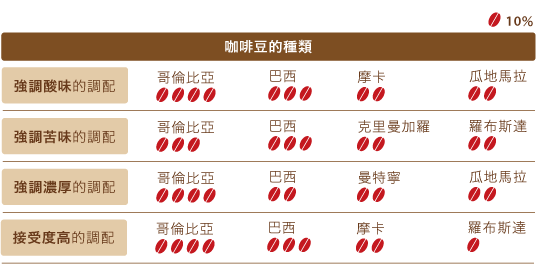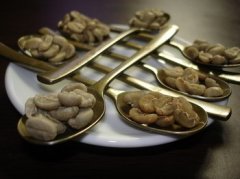What is the difference between blended coffee and single-serve coffee?

For professional baristas, please follow the coffee workshop (Wechat official account cafe_style)
How to make a delicious coffee bean
The term "BLEND" in coffee refers to the combination of several coffee beans of different producing areas and roasting degrees to produce the ideal coffee according to the flavor characteristics of the coffee beans.
Of course, before blending, it is necessary to decide what kind of coffee should be prepared, for example, to emphasize sour taste or bitter taste. After determining the taste, mix it according to the characteristics of various coffee beans. Here are several representative ways of blending coffee.
What's the difference between mixed coffee and individual coffee?
A single product, as its name implies, is a bean from a single producing area.
Blending refers to beans that mix more than two kinds of single coffee.
The purpose of blending beans is to distinguish them from other coffee shops.
The first condition must be that the barista knows the flavor of beans very well.
The selection and matching of the original beans will show only 90 points of flavor through another
The characteristics of a bean, so that the overall flavor has a bonus effect of ♥♥♥
The reason for blending coffee beans
1. For the reason of mixing beans
two。 The taste you want to pursue in your own mind
3. You replenish the pure tonality of individual coffee
4. In order to show the unique aroma and texture of coffee beans
5. You can use cheap coffee beans to control the cost.
What are the naming rules for matching coffee names?
The name of the commodity is an important basis for consumers to judge when they choose and buy. if it causes misunderstanding, it will cause great problems.
When using a trade name, we must first investigate whether there is any infringement on other people's trademark rights. In addition, according to the Fair Competition regulations on the labelling of General concentration Coffee and instant Coffee, the name of blended coffee must meet the following conditions.
To add the origin of raw beans to the trade name, the commodity must contain more than 30% of the coffee from that origin (converted to raw beans). For example, if it is named "Kenyan blended coffee", where raw beans prevail, the product must use more than 30% of Kenyan beans (according to the specifications of the Japan Coffee and Beverage Association, liquid coffee must account for more than 51%). However, the proportion of Kenyan beans does not have to be the highest, and the weight ratio of baked beans is fine even if it is less than 30%.
In addition, according to the definition of the all-Japan Coffee Fair Trade Agreement, raw materials must be used for specific trade names (some examples are given on the next page). Special attention should be paid to this part.
Take "charcoal roasted mocha blended coffee" as an example, if the heat source during baking is used as the trade name, other heat sources cannot be used when roasting coffee beans. Under this principle, it is necessary to use more than 3 ○% (raw beans) of mocha roasted by charcoal fire (Ethiopia or Yemen), as well as charcoal roasted coffee from other places. In addition, if the name of the raw material other than coffee (such as soybeans or dandelions) is added to the trade name, or the words "the highest level" are added without objective basis, it is improper marking.
Important Notice :
前街咖啡 FrontStreet Coffee has moved to new addredd:
FrontStreet Coffee Address: 315,Donghua East Road,GuangZhou
Tel:020 38364473
- Prev

Delicious types, characteristics, brands and production methods of blended coffee
For the exchange of professional baristas, please follow the coffee workshop (Wechat official account cafe_style) spelling coffee spelling: zong he ka fei synonym entry: mixed coffee catalog 1 delicious category 1.1 taste balanced coffee 1.2 bitter coffee 1.3 sour coffee 1.4 flavor coffee 1.5American coffee 1.6full-bodied
- Next

What brand of coffee beans tastes good? Coffee bean variety introduction Coffee bean brand recommendation
Professional coffee knowledge exchange more coffee bean information please follow the coffee workshop (Wechat official account cafe_style) recommended the first grade coffee beans are the blue mountain coffee beans of Jamaica. Blue Mountain Coffee beans win with popular taste and stable quality. Blue Mountain Coffee has a rich and mellow taste, and its flavor, flavor, concentration, acidity and spiciness are all even. it is widely recognized as the best coffee in the world.
Related
- Guji coffee producing area of Guji, Ethiopia: Humbela, Shakiso, Wulaga
- What is the most expensive variety of Qiloso in BOP multi-variety group?
- How to store the coffee beans bought home?
- Why are Yemeni coffee beans so rare now?
- Ethiopian Sidamo all Red Fruit Sun Sun Santa Vini Coffee beans
- SOE is mostly sour? What does it mean? Is it a single bean? what's the difference between it and Italian blending?
- Is Italian coffee beans suitable for making hand-brewed coffee?
- How to choose coffee beans when making cold coffee? What kind of coffee beans are suitable for making cold coffee?
- Just entered the pit to make coffee, what kind of coffee beans should be chosen?
- Can only Japan buy real Blue Mountain Coffee? What are authentic Jamaican Blue Mountain coffee beans?

